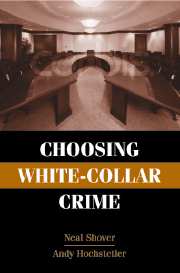1 - White-Collar Crime
Published online by Cambridge University Press: 05 June 2012
Summary
The closing decades of the twentieth century saw dramatic change in the way policy makers and elite academics talk about crime and what should be done about it. In place of the deterministic accounts of its sources that had enjoyed support for decades, they turned to and advanced an interpretation of crime as choice. Seen in this way, aggregate-level crime rates are determined by the supply of opportunities for crime and the number of individuals willing to exploit them. As to the further problem of explaining why only some do so, crime-as-choice theory resurrects an answer advanced by philosophers nearly two centuries ago: they choose. As with all choices, criminal ones are said to be preceded by a decision-making process in which individuals assess options and their potential net payoffs, paying attention particularly to potential aversive consequences. The possibility of arrest and punishment presumably is prominent among these. When viewed through the lens of crime-as-choice theory, crime unambiguously is purposeful and calculated action.
Rational-choice theory gained unrivaled dominance not only as explanation for variation in crime but also as justification for a changed emphasis in crime-control practice. It was pointed out that because the so-called root causes identified in some theories of crime supposedly are beyond the reach of meliorative action by the state, a more appropriate focus is policies and practices meant simply to increase the risks of choosing crime (Wilson, 1975).
- Type
- Chapter
- Information
- Choosing White-Collar Crime , pp. 1 - 26Publisher: Cambridge University PressPrint publication year: 2005
- 2
- Cited by



